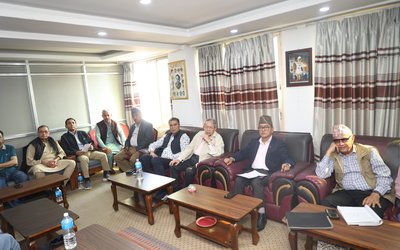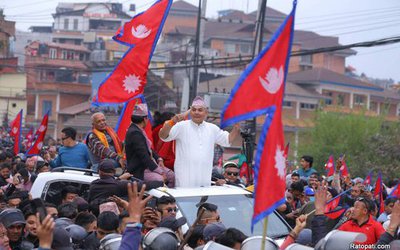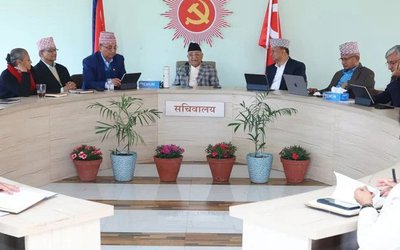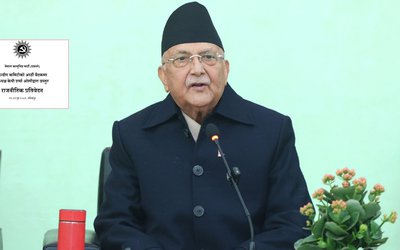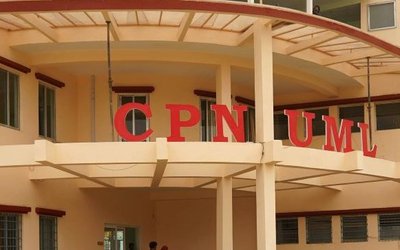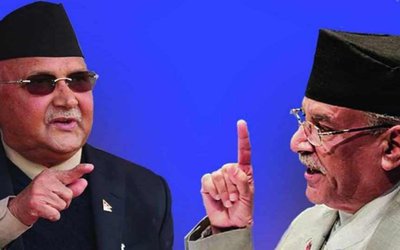
As soon as the Election Commission issued the registration certificate to Communist Party of Nepal Unified Socialist (CPNUS) under the leadership of Madhav Kumar Nepal, years of internal disputes and differences of CPN-UML have come to an end.
With this split, communists have maintained their history of breaking the party and declaring their rival comrade as betrayer, capitalist, bourgeoisie, pro-imperialist, anti-national, anti-democratic and so on. Nepal and Oli, the rival leaders, used these words heavily against each other.
For long, Nepal and Oli had stood side by side, together, to transform a small Naxalites background communist party into a national party with two thirds of majority in the parliament.
Although Maoist Center led by Prachanda and other smaller radical communist parties like Nepal Communist Party Masal, Nepal Workers and Peasants Party and some fringe parties are there, CPN-UML led all the elections and country’s political sphere under the leadership of Nepal and Oli.

Nepal and Oli: Different Characters
Although CPN-UML leaders Madhav Kumar Nepal and K.P. Sharma Oli shared power for long to drive CPN-UML and made it the largest political party of Nepal, their personal backgrounds and family backgrounds are different.
Born in a middle class Brahmin family in Rautahat District, Nepal, who joined the communist movement in his school days, was groomed in an extended family in Gaur. With enough cultivated land, Nepal’s family was economically moderate.
However, this was not with K.P. Sharma Oli whose parents migrated from Hill to Jhapa as a marginal farmer. Nepal joined the communist movement with moderate leaders. However, Oli joined the communist movement as a rebel for a revolution that aimed to wipe out landlords.
Recently migrated, Oli’s parents had a bit of difficulty in terms of economic status. Thus, Oli relied on Mainali duo of Jhapa and founders of infamous Jhapa movement to pursue his rebellion.
From his moderate family, Nepal learned the skill of accommodation and reconciliation. However, Oli was groomed in a different atmosphere. Oli’s thought is inspired by elimination of enemy class whereas Nepal has the spirit of accommodation.
Oli is blunt, cunning and skilful in attracting the masses. However, Nepal is sober, comparatively with lesser skills of attracting the masses. CPN-UML thrived because Nepal’s skill of building organization with compromise and Oli’s cunning leadership quality to attract the mass.

Legacy of Party
Inheriting a strong legacy from popular communist leader Madan Bhandary, who died in a mysterious jeep accident along with his colleague Jeev Raj Ashrit, Nepal and Oli duo, though both of them have different political backgrounds, with Nepal being is more on the Marxist side and Oli being a radical Naxalite, had been able to put the party in the current position.
In attracting the masses, late Bhandary knew the skill and had a way to lure the people. The quality of attracting the mass helped him to defeat Nepali Congress leader Krishna Prasad Bhattarai in general elections in 1990. This win against Bhattarai changed the political future of CPN-UML and landscape of politics of Nepal.
Although the party faced a major split led by Bam Dev Gautam, CP Mainali and others in 1997 on Mahakali ratification issues, Nepal and Oli were able to establish the party’s position compelling Gautam’s group to merge again.
Facing all kinds of turmoil, Nepal and Oli led the party jointly, hand by hand. They crushed the internal rebellion successfully time and again forcing many founding members and big stalwarts like Radha Krishna Mainali, CP Mainali, Devi Prasad Ojha, Mohan Chandra Adhikari and Ashok Rai and so many others to quit it.
Following the peace agreement, Nepal Communist Party Maoist, a rebel party led by Pushpa Kamal Dahal and Dr. Baburam Bhattarai emerged as a main challenger to CPN-UML base. In 2008 Constituent Assembly Elections, CPN-UML was nearly wiped out due to the Maoists.

However, the euphoria of Maoist party did not last long. It faded away within three years. In the second elections of Constituent Assembly, CPN-UML, under the leadership of Nepal and Oli, retained its position emerging as the second largest party, pushing Maoists into the third place.
With the promulgation of new constitution and rise of K.P. Sharma Oli as prime minister in 2016, the political reality of Nepal changed. In the local elections of 2017 and national and provincial level of 2018, the election alliance with Maoist had paid Nepal and Oli party well.

The alliance secured two thirds majority wiping out Nepal’s oldest Nepali Congress Party as if it was nowhere. Out of 165 seats contested, Nepali Congress secured just 18 seats and remaining seats went to CPN-UML and Maoist Center alliance.
The merger of 2019 between CPN-UML and Maoist Center had completely changed Nepal’s political landscape and communist alliance emerged as the largest party in Nepal. However, this unity turned out costly for both the factions as they split again.
With the rise of CPN-UML under the leadership of Nepal and Oli, many communist leaders turned as politically irrelevant. Rising as a small party backed by students in 1990, CPN-UML today held most important positions including President, Prime Minister and Ministers. Many of CPN-UML’s sympathizers and party members are leading judiciary and other bureaucratic positions.
Although some of his die-hard supporters, who pushed former general secretary Nepal to the brink to break relations with Oli, have returned to Oli camp at the last minute, former PM Nepal, a well know communist politician with a caliber of political maneuvering, has the task to show that the split cannot make any difference to him about the followers and defectors.
Merging between CPN-ML and Nepal Communist Party Marxist, the Communist Party of Nepal (Unified Marist Leninist) was born in 1991 after the political change of 1990. There were several splits of small scale happening.
After the split in 1997 on the issue of ratification of Mahakali Treaty by Bam Dev Gautam led group against Nepal and Oli led CPN-UML, this is the second major split in the party.
After a long process of verifications and application, the Election Commission (EC) has recognized the CPN (Unified Socialist) as a new political party. A meeting of the EC office bearers in the evening of 25 August gave the verification certificate to the CPN (Unified Socialist) led by Nepal.
Although the EC also recognized new political party, Democratic Socialist Party -led by Mahantha Thakur on the same day, the split of CPN-UML under a political heavyweight Nepal is politically important.
With the verification of 56 central members and 30 parliamentarians, the EC registered the new party based on the Ordinance on political parties, 2078 BS.

Nepal’s Statement
“I had never imagined splitting the party. However, we are compelled to choose this way and open a new party as UML Chair KP Sharma Oli had closed the doors for us and our supporters,” said Nepal. “Oli attempted to block all avenues with the intention of preventing him from opening a new party or exposing his wrong deeds.”
Although almost two dozen of his close comrades including senior leader Bhim Rawal, Yubraj Gyawali, Amrit Bohara, Astalaxmi Shakya, Raghuji Panta, Ghanshyam Bhusal and Yogesh Bhattarai deserted him at the last minute and returned to Oli led faction, Nepal, who has faced all political humiliation in the last several years from Oli, did not change his mind.
With the support from former Prime Minister Jhalnath Khanal and large numbers of other supporters, Nepal has shown that there is a limit to tolerance from humiliation.
“We had two options - surrender to Oli or open a revolutionary party. Although we are a different party, we are ready for unity or electoral alliance with communist forces,” said Nepal.
Ideological Base
Although there are two CPN-UML factions with different tail name led by Oli and Nepal, both the parties still hold the same ideology. They will have different election symbols but both the parties have similar flags of sickle and hammer and same posters. Only difference between them are party leaders and elections symbols and one is in ruling side and the other is in opposition.
Chairman of newly formed CPN -Unified Socialist Nepal has made it clear that his party has set a goal to move forward on the path of socialism by protecting the norms and values of people's multi-party democracy.
The ideology of people’s multi-party democracy propounded by Madan Bhandari is also the core base of Oli led CPN-UML.
The new party believes that freedom with equality could be achieved by ending oppression and discrimination, and the party statute mentioned that party's strategic goal is scientific socialism.
The statute mentioned that building a basis for socialism along with social justice and democratic norms and values by developing national capitalism with the country's socio and economic transformation through peaceful struggle and democratic means are the short-term goals of the party.

“We set up a new party rebelling against wrong tendencies, ideas and values,” said Nepal addressing the media gathering. “We all are equal and there will be no discrimination against any members of our party.” Former Prime Minister Nepal clarified that they had to revolt as the CPN (UML) leadership did not follow any rules and regulations.
There would be a 151-member central committee including 115 full members with 17 office-bearers comprising one chairperson, one senior leader, seven vice-chairpersons, one general-secretary and seven secretaries as well as 36 alternative members.
Nepal has said it will move forward on the path of socialism by protecting the norms and values of people's multi-party democracy, a political notion propagated by the late UML general secretary Madan Bhandari.
The CPN (UML) has already adopted ‘people's multi-party democracy’ as its guiding principle.
History of CPN-UML
Following the dissolution of parliamentary system and banning of political parties in 1961 by King late Mahendra, Nepal Communist Party also went to exile in India. This paved the way for the division of the party.

Following the division in international communist movements into Soviet Union led faction and Mao led Chinese ideology, Nepalese communists also got divided into two factions.
Supported by then Soviet Union, late Keshar Jung Rayamajhi headed the Nepal Communist Party that was ideologically closer to Soviet Union. Similarly, there were many Communist groups opposed to this camp with claims to be the follower of Mao’s revolution.
Within pro-Maoist communist party, the Naxalite party was born in Jhapa led by R.K. Mainali, CP Mainali, K.P. Oli, Jhalnath Khanal and others. At that time youth leaders like Madhav Kumar Nepal were in the middle as Nepal Communist Party Marxist was active under the leadership of Man Mohan Adhikary.
Established with the unification of Kosi Coordination Committee, Naxal Groups and a faction of dissolved Nepal Communist Party in 1976, CPN-UML emerged integrating all, including Nepal Communist Party Marxist.
Although Nepal Communist Party was established in 1949, there are over two dozen communist parties existing as UML split following 2054 BS over the issue related to the Mahakali treaty.
Split in CPN-UML will have long and short term implications in the country’s politics. This split will put Nepal into a chaotic and unstable political course with Prachanda led Maoist, Nepal led CPN-UML Unified Socialist and other fringe communists on one side and Oli led CPN-UML on the other side.
Reaction In CPN-UML
Just a day after the EC issued a certificate of registration to new party, CPN-UML has announced to hold 10th General Convention from November 26 to 28, 2021. Forced by newly formed party to retain the party workers from leaving it, Oli led CPN-UML had no option other than to announce this.
To show his more accommodative and tolerable posture, Oli has formed a seven-member Task Force led by rebel Vice Chairman Bhim Rawal to nominate 10 percent central members and give full shape to the party's various departments.
CPN-UML also formed a Task Force to sort out all the differences and address the demands. The committee includes Vice Chairman Rawal, General Secretary Ishwar Pokharel, Deputy General Secretaries duos Bishnu Prasad Poudel and Ghanashyam Bhusal and Standing Committee members Surendra Pandey and Lekha Raj Bhatta.
Although CPN-UML leader and former prime minister Oli has still many advantages in the party and national politics with big coffers in hand and set up of erstwhile organizations, Nepal’s rebellion from the party has to pay him heavy cost.
As CPN-UML has already lost two provincial governments including Lumbini and Gandaki, it will be difficult for UML to retain two remaining governments in Bagmati and Province 1.
Replacing his loyalist chief minister in Bagmati province to reward Ashta Laxmi Shakya as new chief minister, Oli has for now temporarily kept control of the government. However, the formation of new party under the leadership of Madhav Kumar Nepal can make many differences.


Keshab Poudel
Poudel is the editor of New Spotlight Magazine.
- KUL MAN GHISING: Bowing Down To The People
- Apr 13, 2025
- POLITICAL VIOLENCE: Culture of Impunity
- Apr 11, 2025
- PM OLI MEETS PM MODI: No Progress
- Apr 09, 2025
- PM OLI’S THAILAND VISIT: Flip Flop
- Apr 08, 2025
- FM Dr. Deuba’s India Visit: Mission Aborted
- Mar 26, 2025
